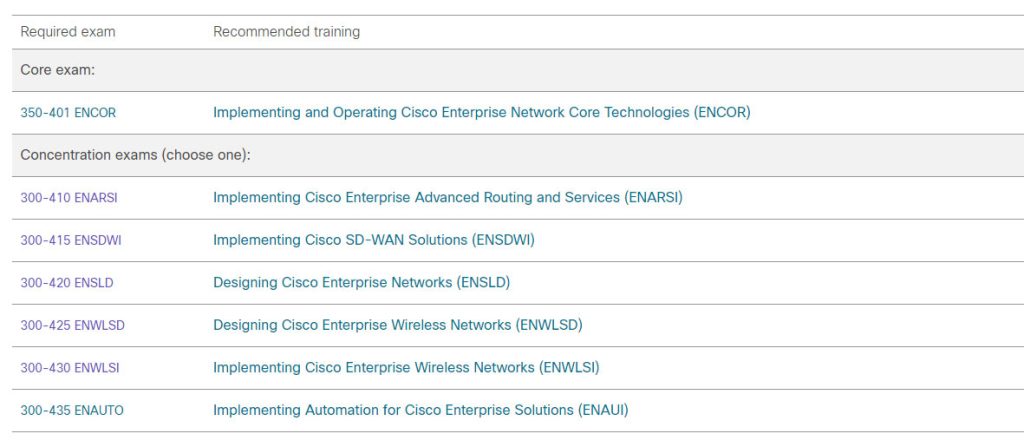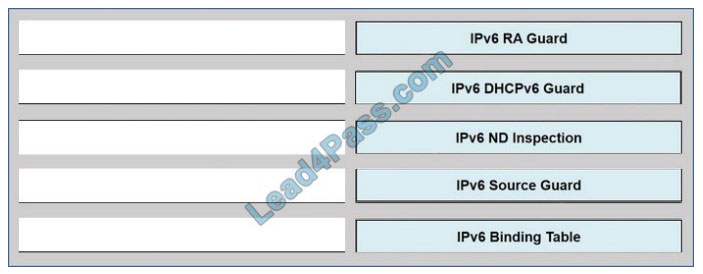300-410 Dumps exam questions for the current latest and actual Cisco 300-410 ENARSI Exam Materials.
Lead4Pass 300-410 dumps page https://www.leads4pass.com/300-410.html, you can see two buttons, PDF and VCE, whichever one you choose can help you learn quickly and successfully pass Cisco 300 -410 ENARSI Exam.
I believe you know that the Cisco 300-410 ENARSI certification is very popular today, and passing this exam can help you broaden your career path.
The right choice and effective referrals are the ones that can help you avoid detours and achieve success easily. Lead4Pass 300-410 Dumps helps you succeed in Cisco 300-410 ENARSI Exam on your first attempt.
Share some Cisco 300-410 ENARSI Exam details:
Whether you are a novice or an exam candidate next I will share some basic information about Cisco 300-410 ENARSI Exam.
ENARSI is the abbreviation of Implementing Cisco Enterprise Advanced Routing and Services exam name, you can check the specific information:
Vendor: Cisco
Exam Code: 300-410
Exam Name: Implementing Cisco Enterprise Advanced Routing and Services (ENARSI)
Certification: CCNP Enterprise
Duration: 90 minutes
Languages: English and Japanese
Price: $300 USD
Rules for the CCNP Enterprise certification exam:

I think you should understand that the Cisco 300-410 ENARSI Exam is one of the centralized exams, come here to say it’s your choice. And to get CCNP Enterprise certification, you pass two exams: one that covers core enterprise technologies and one enterprise concentration exam of your choice.
I won’t go into more detail here, I recommend you a Cisco collection site: VCEcert.com. You’ll get a community of free Cisco exam questions and answers to help you with any exam.
Maybe you are wondering what are the core issues of the Lead4Pass 300-410 dumps:
300-410 exam questions and answers based on the real core content of the Cisco 300-410 ENARSI Exam and verified by the test center:
- Layer 3
- VPN services
- Infrastructure security
- Infrastructure services
- Infrastructure automation
Next, read a portion of the free 300-410 Dumps exam questions and answers online:
QUESTION 1:
An engineer needs dynamic routing between two routers and is unable to establish OSPF adjacency. The output of the show ip ospf neighbor command shows that the neighbor state is EXSTART/EXCHANGE. Which action should be taken to resolve this issue?
A. match the passwords
B. match the hello timers
C. match the MTUs
D. match the network types
Correct Answer: C
The problem occurs most frequently when attempting to run OSPF between a Cisco router and another vendor\’s router. The problem occurs when the maximum transmission unit (MTU) settings for neighboring router interfaces don\’t match. If the router with the higher MTU sends a packet larger than the MTU set on the neighboring router, the neighboring router ignores the packet.
QUESTION 2:
Refer to the exhibit. Users report that IP addresses cannot be acquired from the DHCP server. The DHCP server is configured as shown. About 300 total nonconcurrent users are using this DHCP server, but none of them are active for more than two hours per day. Which action fixes the issue within the current resources?

A. Modify the subnet mask to the network 192.168.1.0 255.255.254.0 command in the DHCP pool
B. Configure the DHCP lease time to a smaller value
C. Configure the DHCP lease time to a bigger value
D. Add the network 192.168.2.0 255.255.255.0 command to the DHCP pool
Correct Answer: B
QUESTION 3:
You recently implemented SNMPv3 to increase the security of your network management system. A partial output of the show run command displays the following output that relates to SNMP.
snmp-server group NORMAL v3 noauth read NORMAL write NORMAL
Which of the following statements is true of this configuration?
A. it provides encryption, but it does not provide authentication
B. it provides neither authentication nor encryption
C. it provides authentication, but it does not provide encryption
D. it provides both authentication and encryption
Correct Answer: B
It provides neither authentication nor encryption. In SNMPv3 there are three combinations of security that can be used:
noAuthNoPriv- no authentication and no encryption noauth keyword in the configuration AuthNoPriv – messages are authenticated but not encrypted auth keyword in the configuration AuthPriv – messages are authenticated and encrypted priv keyword in the configuration In this case, the keyword noauth in the configuration indicates that no authentication and no encryption are provided. This makes the implementation no more secure than SNMPv1 or SNMPv2.
In SNMPv1 and SNMPv2, authentication is performed using a community string. When you implement SNMP using the noauth keyword, it does not use community strings for authentication. Instead it uses the configured user or group name (in this case NORMAL). Regardless, it does not provide either authentication or encryption.
Objective:
Infrastructure Services
Sub-Objective:
Configure and verify SNMP
References:
SNMP Configuration Guide, Cisco IOS XE Release 3SE (Catalyst 3850 Switches) > SNMPv3
QUESTION 4:
Refer to the exhibit.

A network administrator is discovering a Cisco Catalyst 9300 and a Cisco WLC 3504 in Cisco DNA Center. The Catalyst 9300 is added successfully. However, the WLC is showing the error “uncontactable” when the administrator tries to add it to Cisco DNA Center.
Which action discovers WLC in Cisco DNA Center successfully?
A. Delete the WLC 3504 from Cisco DNA Center and add it to Cisco DNA Center again.
B. Add the WLC 3504 under the hierarchy of the Catalyst 9300 connected devices.
C. Copy the .cert file from the Cisco DNA Center on the USB and upload it to the WLC 3504.
D. Copy the .pem file from the Cisco DNA Center on the USB and upload it to the WLC 3504.
Correct Answer: D
QUESTION 5:
Refer to the exhibit.R4 is experiencing a packet drop when trying to reach 172.16.2.7 behind R2. Which action resolves the issue?

A. Insert a /24 floating static route on R2 toward R3 with metric 254.
B. Disable auto summarization on R2.
C. Insert a /16 floating static route on R2 toward R3 with metric 254.
D. Enable auto summarization on all three routers R1, R2, and R3.
Correct Answer: B
QUESTION 6:
Refer to the exhibit.

An IP SLA is configured to use the backup default route when the primary is down, but it is not working as desired. Which command fixes the issue?
A. R1(config)# ip route 0.0.0.0.0.0.0.0.2.2.2.2 10 track 1
B. R1(config)# ip route 0.0.0.0.0.0.0.0.2.2.2.2
C. R1(config)#ip sla track 1
D. R1(config)# ip route 0.0.0.0.0.0.0.0.1.1.1.1 track 1
Correct Answer: D
Note: By default Static Router AD value-1 hence IP route 0.0.0.0. 0.0.0.0. 1.1.1.1 track 1 means AD-1 which must be less than of backup route AD.
Define the backup route to use when the tracked object is unavailable.
!— The administrative distance of the backup route must be greater than
!— the administrative distance of the tracked route.
!— If the primary gateway is unreachable, that route is removed
!— and the backup route is installed in the routing table !— instead of the tracked route. Reference:
https://www.cisco.com/c/en/us/support/docs/ip/ip-routing/200785-ISP-Failover-with-default-routes-using-I.html https://www.cisco.com/c/en/us/support/docs/security/asa-5500-x-series-next-generation-firewalls/118962-configure-asa-00.html
QUESTION 7:
A network engineer needs to verify IP SLA operations on an interface that shows an indication of excessive traffic.
Which command should the engineer use to complete this action?
A. show frequency
B. show track
C. show reachability
D. show threshold
Correct Answer: B
QUESTION 8:
Which attribute eliminates LFAs that belong to protected paths in situations where links in a network are connected through a common fiber?
A. Shared Risk Link Group (SRLG)-disjoint
B. linecard-disjoint
C. lowest-repair-path-metric
D. interface-disjoint
Correct Answer: A
LFA Tie-Breaking Rules
When there are multiple candidate LFAs for a given primary path, EIGRP uses a tie-breaking rule to select one LFA per
primary path per prefix. A tie-breaking rule considers LFAs that satisfy certain conditions or have certain attributes.
EIGRP uses the following four attributes to implement tie-breaking rules:
–
Interface-disjoint—Eliminates LFAs that share the outgoing interface with the protected path.
–
Linecard-disjoint—Eliminates LFAs that share the line card with the protected path.
–
Lowest-repair-path-metric—Eliminates LFAs whose metric to the protected prefix is high. Multiple LFAs with the same lowest path metric may remain in the routing table after this tie-breaker is applied.
–
Shared Risk Link Group (SRLG)-disjoint—Eliminates LFAs that belong to any of the protected path SRLGs. SRLGs refer to situations where links in a network share a common fiber (or a common physical attribute). If one link fails, other links in the group may also fail. Therefore, links in a group share risks.
QUESTION 9:
Refer to the exhibit. The DHCP client is unable to receive an IP address from the DHCP server. RouterB is configured as follows:

Which command is required on the FastEthernet 0/0 interface of RouterB to resolve this issue?
A. RouterB(config-if)#lp helper-address 172.31.1.1
B. RouterBiconfig-ififclp helper-address 255.255 255 255
C. RouterB(config-if)#lp helper-address 172.16.1.1
D. RouterB(config-if)#lp helper-address 172.16.1.2
Correct Answer: D
QUESTION 10:
DRAG DROP
Drag and Drop the IPv6 First-Hop Security features from the left onto the definitions on the right.
Select and Place:

Correct Answer:

+
Block reply and advertisement messages from unauthorized DHCP servers and relay agents: IPv6 DHCPv6 Guard
+
Create a binding table that is based on NS and NA messages: IPv6 ND Inspection
+
Filter inbound traffic on Layer 2 switch port that are not in the IPv6 binding table: IPv6 Source Guard
+
Block a malicious host and permit the router from a legitimate route: IPv6 RA Guard
+
Create IPv6 neighbors connected to the device from information sources such as NDP snooping: IPv6 Binding Table
QUESTION 11:
Refer to the exhibit.

A network administrator is using the DNA Assurance Dashboard panel to troubleshoot an OSPF adjacency that failed between Edge_NYC Interface GigabitEthernet1/3 with Neighbor Edge_SNJ. The administrator observes that the neighborship is stuck in an extracted state.
How does the administrator fix this issue?
A. Configure to match the OSPF interface network types on both routers.
B. Configure to match the OSPF interface speed and duplex settings on both routers.
C. Configure to match the OSPF interface MTU settings on both routers.
D. Configure to match the OSPF interface unique IP address and subnet mask on both routers.
Correct Answer: C
https://www.cisco.com/c/en/us/support/docs/ip/open-shortest-path-first-ospf/13684-12.html
After two OSPF neighboring routers establish bi-directional communication and complete DR/BDR election (on multi-access networks), the routers transition to the exstart state. In this state, the neighboring routers establish a master/slave relationship and determine the initial database descriptor (DBD) sequence number to use while exchanging DBD packets. Neighbors Stuck in Exstart/Exchange State The problem occurs most frequently when attempting to run OSPF between a Cisco router and another vendor\’s router. The problem occurs when the maximum transmission unit (MTU) settings for neighboring router interfaces don\’t match. If the router with the higher MTU sends a packet larger than the MTU set on the neighboring router, the neighboring router ignores the packet.
QUESTION 12:
What are the two functions of LDP? (Choose two.)
A. It advertises labels per Forwarding Equivalence Class.
B. It uses Forwarding Equivalence Class.
C. It is defined in RFC 3038 and 3039.
D. It requires MPLS Traffic Engineering.
E. It must use Resource Reservation Protocol.
Correct Answer: AB
QUESTION 13:
How is VPN routing information distributed in an MPLS network?
A. It is controlled through the use of RD.
B. The top level of the customer data packet directs it to the correct CE device.
C. It is established using VPN IPsec peers.
D. It is controlled using VPN target communities.
Correct Answer: D
https://www.ccexpert.us/mpls-design/chapter-5-packetbased-mpls-vpns.html
……
Free 300-410 Dumps Exam Questions and Answers Online Download: https://drive.google.com/file/d/1Hmd2m8IlFiln0lDicik9brJDd0T1caJr/view?usp=sharing
View 548 exam questions and answers: Click Here.
